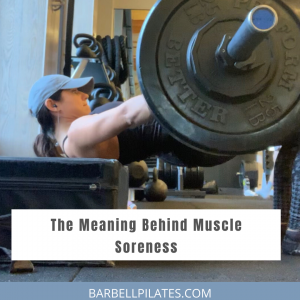There are a lot of things in the fitness world that make me cringe:
- Curling in the squat rack
- Anyone that says lifting heavy makes women “big”
- Using muscle soreness as the end-all-be-all sign that an exercise is “working”
- Literally anything with pink dumbbells
Number #3 is one that really grinds my gears most because far too many fitness certified coaches with actual experience training humans “influencers” are out there piecing together workouts that do nothing but make you feel sore.
You can get sore doing a lot of dumb sh*t in the gym. You can also get sore by doing the right things. Either way, muscle soreness is a natural response to the stressors you place on your body, and exercise (dumb or not) is a stressor.
⠀⠀⠀⠀⠀⠀⠀⠀⠀
Any time you experience a new movement, more volume, more intensity, or an exercise you haven’t done in a while, your body will likely respond with them DOMS (delayed onset muscle soreness) 24-72 hours after.⠀⠀
⠀⠀⠀⠀
However, muscle soreness is often overvalued, and sets people further back instead of forward toward their goals.

What does it all mean?
When it comes down to it, muscle soreness, or DOMS, is just a response to something you did, and should be used as information, not as the end goal.
⠀⠀⠀⠀⠀⠀⠀⠀⠀
❌ Muscle soreness does not mean you’re building muscle or getting stronger
⠀⠀⠀⠀⠀⠀⠀⠀⠀
❌ Muscle soreness is not an indicator of exercise efficacy
⠀⠀⠀⠀⠀⠀⠀⠀⠀
❌ Soreness can actually derail your progress if it puts you out of commission for days at time ⠀⠀⠀⠀⠀⠀⠀⠀⠀
Stop. Chasing. Muscle. Soreness.
Seriously, Amanda. STOP IT.
Chasing after the burn and placing too much value on how sore you feel the day after isn’t going to help you get anywhere.
Signs Your Training Is Working That Isn’t DOMS
Like anything with training, muscle soreness is a symptom of something you do. It’s normal and if you take a few days off from exercise or haven’t done a certain movement in a while, almost guaranteed you’ll feel sore after.
Rather than being the kind of person who chases after programs or training modalities based off how sore it makes you, here are some simple ways to measure the effectiveness of a program that has nothing to do with feeling sore:⠀⠀⠀⠀⠀⠀⠀⠀
- An effective program might make you sore sometimes, but it shouldn’t occur after every session.
- Read the above one again. Let it sink in
- You should be able to go about your daily life a day or two after being sore. If not, you did too much. Dial it back next time, sister!
- You see more muscle definition in your body than ever
- You have more energy
- You are hitting new PRs and seeing improvements in skill
- You are enjoying how you look in the mirror
- You can carry all your groceries inside in one trip without any help
Put it simply…
Effective, progressive program > Soreness ⠀⠀⠀⠀⠀⠀⠀⠀⠀
Every time.
When I’m training my clients in-person or inside BarbellSTRONG 1:1, I almost never ask about their soreness level unless it’s solely to gauge if we went a little too hard and/or need to back off on something new. It’s probably one of the least important factors in a training program. Nothing beats progressive overload in a training program.
Ready to make gains? Join me inside BarbellSTRONG

